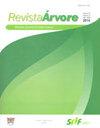大西洋森林遗迹中边缘对功能性树木性状的影响
IF 0.8
4区 农林科学
Q4 FORESTRY
引用次数: 0
摘要
生境破碎化是边缘发生及其影响的主要原因之一。树木的功能特征,如木材密度、高度和直径是可以推断几个生态过程的基本变量。本研究评估了森林遗迹两种生境(边缘和内部)树木功能性状的变异性。检验的假设是i)功能性状在边缘的值比内部的值低,ii)环境变量会影响这种差异。本研究在巴西Serra da Tiririca州立公园内最大的大西洋森林遗迹中进行,在不同的栖息地中建立了10个样地(50 × 20 m)。在每个样地内,从直径= 10 cm的所有树木中采集木材样本。记录海拔高度、地块到边缘的距离和火灾记录作为可能的解释变量(环境变量)。采用浸渍法测定木材密度。为了验证生境对功能性状的差异,采用了Wilcoxon检验。此外,通过广义线性模型评估了解释变量对功能性状的影响。在地边所记的树木有一百八十五棵,在馀地里面所记的树木有二百一十八棵。树木密度和树高在边缘处显著低于内部。此外,最佳模型还显示了木材密度与生境、直径和到边缘的距离之间的显著关系。该研究有效地提出了预测边缘效应的合适变量。本文章由计算机程序翻译,如有差异,请以英文原文为准。
EDGE INFLUENCE OVER FUNCTIONAL TREE TRAITS IN AN ATLANTIC FOREST REMNANT
ABSTRACT Habitat fragmentation is one of the leading causes of edge genesis and its effects. Functional tree traits such as wood density, height, and diameter are essential variables from which it is possible to infer several ecological processes. This study assessed the variability of the functional traits of trees over two habitats (edge and interior) of a forest remnant. The hypothesis tested were i) the functional traits would have lower values at the edges than the interior, and ii) environmental variables would influence such differences. This study was carried out in the largest Atlantic Forest remnant within Serra da Tiririca State Park, Brazil, by establishing ten plots (50 × 20 m) among different habitats. Within each plot, wood samples were taken from all trees with a diameter of = 10 cm. It was recorded the altitude, distance from the plots to the edge, and fire records as possible explanatory variables (environmental variables). Wood density was obtained using the immersion method. To verify differences in functional traits by habitat, the Wilcoxon test was applied. Additionally, the influence of explanatory variables on functional traits through generalized linear models was evaluated. One hundred eighty-five trees were recorded at the edges and 218 trees at the interior of the remnant. Wood density and tree height were significantly lower in the edges than in the interior. Furthermore, the best models indicated significant relationships between wood density and habitats, as well as diameter and distance to the edge. This study was effective in raising suitable variables to predict edge effects.
求助全文
通过发布文献求助,成功后即可免费获取论文全文。
去求助
来源期刊

Revista Arvore
FORESTRY-
CiteScore
1.00
自引率
0.00%
发文量
32
审稿时长
4-8 weeks
期刊介绍:
A Revista Árvore é um veículo de comunicação científica da Sociedade de Investigações Florestais – SIF. O jornal é de acesso gratuito, revisado por pares, que publica bimestralmente trabalhos científicos originais no campo da Ciência Florestal. As áreas temáticas para publicação são: Ambiência e Conservação da Natureza, Manejo Florestal, Silvicultura e Tecnologia da Madeira e Utilização de Produtos Florestais.
A política editorial visa manter alta conduta ética em relação à publicação e aos seus funcionários, rigor na qualidade dos artigos científicos, seleção de revisores qualificados, respeito profissional aos autores e processo de tomada de decisão imparcial. A Revista Árvore publica artigos apenas em inglês.
Artigos de revisão podem ser publicados se houver uma discussão relevante resumindo o estado da arte sobre o assunto. A revisão estrita da literatura não é aceita.
 求助内容:
求助内容: 应助结果提醒方式:
应助结果提醒方式:


